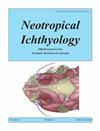对澳洲Pyrrhulina(特征:Lebiasinidae)的DNA条形码分析揭示了该类群中意想不到的隐型多样性
IF 2
4区 生物学
Q1 ZOOLOGY
引用次数: 0
摘要
Lebiasinidae科包括许多新热带地区特有的微型和中型鱼类。Pyrrhulina是种类第二多的lebiasic属,也是分类不确定性最大的属。在此背景下,本研究的重点是在南美洲许多不同流域发现的Pyrrhulina形态种,以测试基于DNA条形码方法的关于在假定为单一名义物种的分类单位安排的替代建议。分析结果表明,南方Pyrrhulina是一个物种复合体,种内(群内)遗传距离高达3.74%,远高于本研究定义的最佳阈值1.79%。物种划分分析显示,在被评估的形态物种中,存在着令人惊讶的多样化水平,特别是在包括Pyrrhulina australis(来自巴拉圭河)+ P. cfr . rachoviana(下帕拉纳本文章由计算机程序翻译,如有差异,请以英文原文为准。
DNA Barcoding of Pyrrhulina australis (Characiformes: Lebiasinidae) reveals unexpected cryptic diversity in the group
Abstract The family Lebiasinidae includes a number of miniature and medium-sized fish species that are endemic to the Neotropical region. Pyrrhulina is the second most speciose lebiasinid genus and it is also the one with the most taxonomic uncertainties. In this context, the present study focused on the Pyrrhulina morphospecies found in a number of different drainage basins in South America to test the alternative proposals on the arrangement of the taxonomic units found within what is assumed to be a single nominal species, Pyrrhulina australis, based on a DNA Barcoding approach. The results of the analyses indicate that Pyrrhulina australis is a species complex, with intraspecific (within-group) genetic distances of up to 3.74%, well above the Optimal Threshold of 1.79% defined in the present study. The species delimitation analyses revealed a surprising level of diversification among the morphospecies evaluated, in particular, in the clade that encompasses Pyrrhulina australis (from the Paraguay River) + P. cf. rachoviana (Lower Paraná River), P. aff. australis I (Araguaia River)/II (Paraguay River)/III (Upper Paraná River)/IV(Guaporé River),and P. marilynae (Teles Pires River), which were arranged in six distinct evolutionary lineages that align with the geographical distribution of the respective drainage basins.
求助全文
通过发布文献求助,成功后即可免费获取论文全文。
去求助
来源期刊

Neotropical Ichthyology
生物-动物学
CiteScore
2.80
自引率
17.60%
发文量
24
审稿时长
6-12 weeks
期刊介绍:
Neotropical Ichthyology is the official journal of the Sociedade Brasileira de Ictiologia (SBI). It is an international peer-reviewed Open Access periodical that publishes original articles and reviews exclusively on Neotropical freshwater and marine fishes and constitutes an International Forum to disclose and discuss results of original research on the diversity of marine, estuarine and freshwater Neotropical fishes.
-Frequency: Four issues per year published only online since 2020, using the ‘rolling pass’ system, which posts articles online immediately as soon as they are ready for publication. A searchable and citable Digital Object Identifier (DOI) is assigned to each article immediately after online publication, with no need to await the issue’s closing.
-Areas of interest: Biology, Biochemistry and Physiology, Ecology, Ethology, Genetics and Molecular Biology, Systematics.
-Peer review process: The Editor-in-Chief screens each manuscript submitted to Neotropical Ichthyology to verify whether it is within the journal’s scope and policy, presents original research and follows the journal’s guidelines. After passing through the initial screening, articles are assigned to a Section Editor, who then assigns an Associate Editor to start the single blind review process.
 求助内容:
求助内容: 应助结果提醒方式:
应助结果提醒方式:


